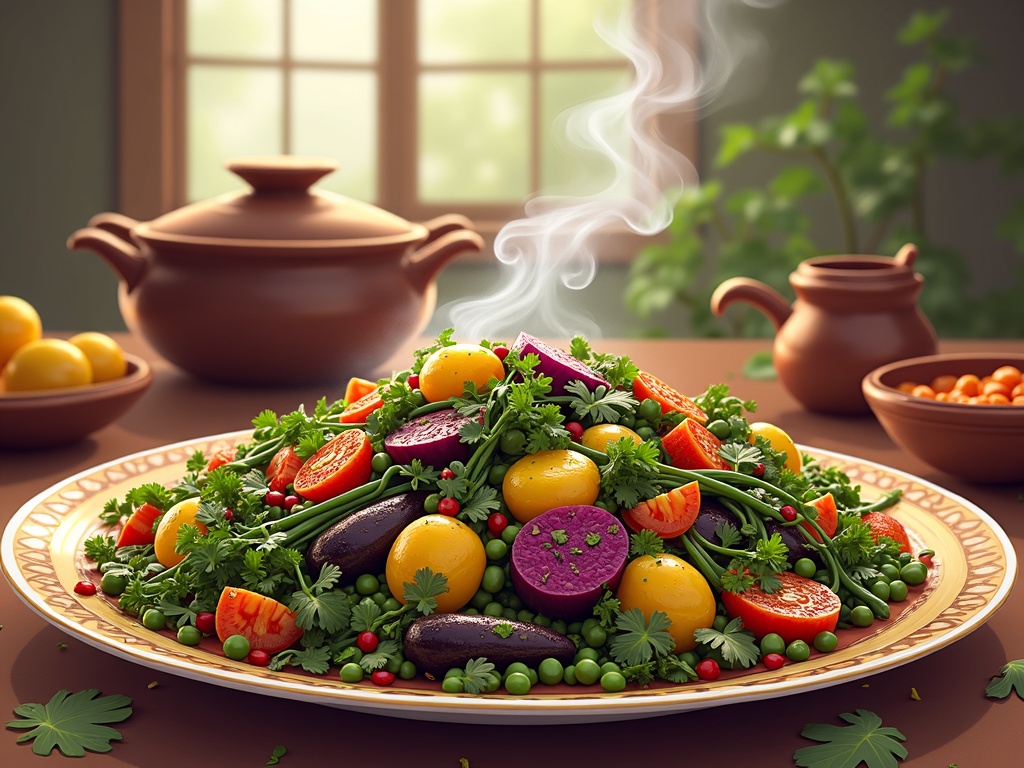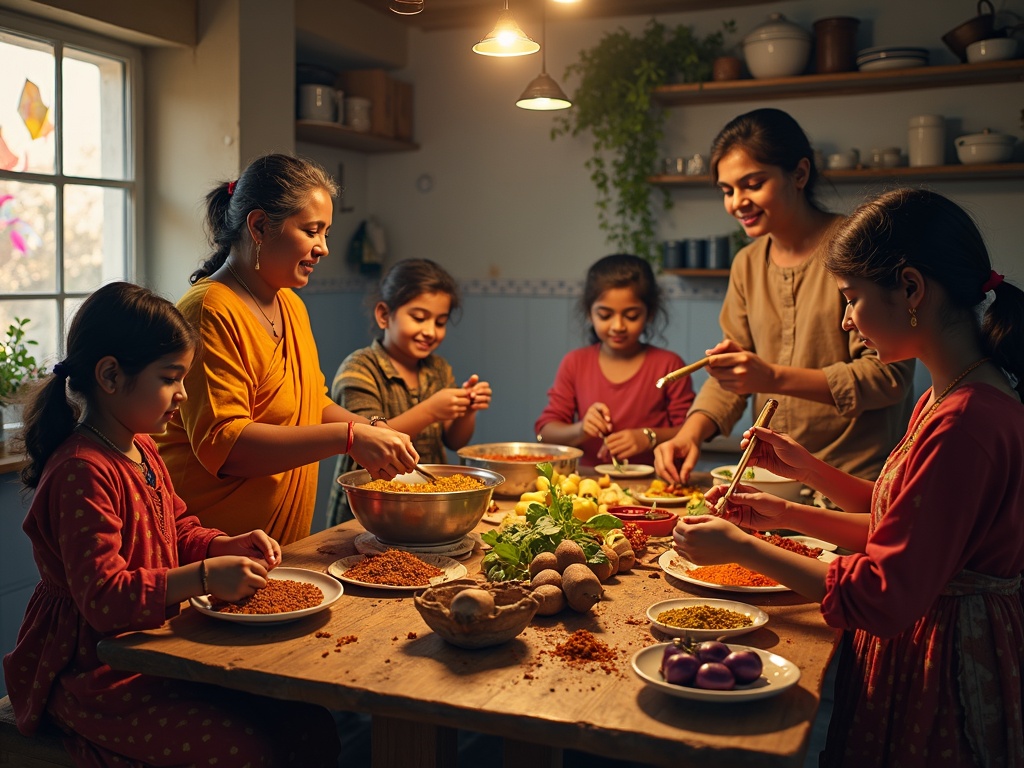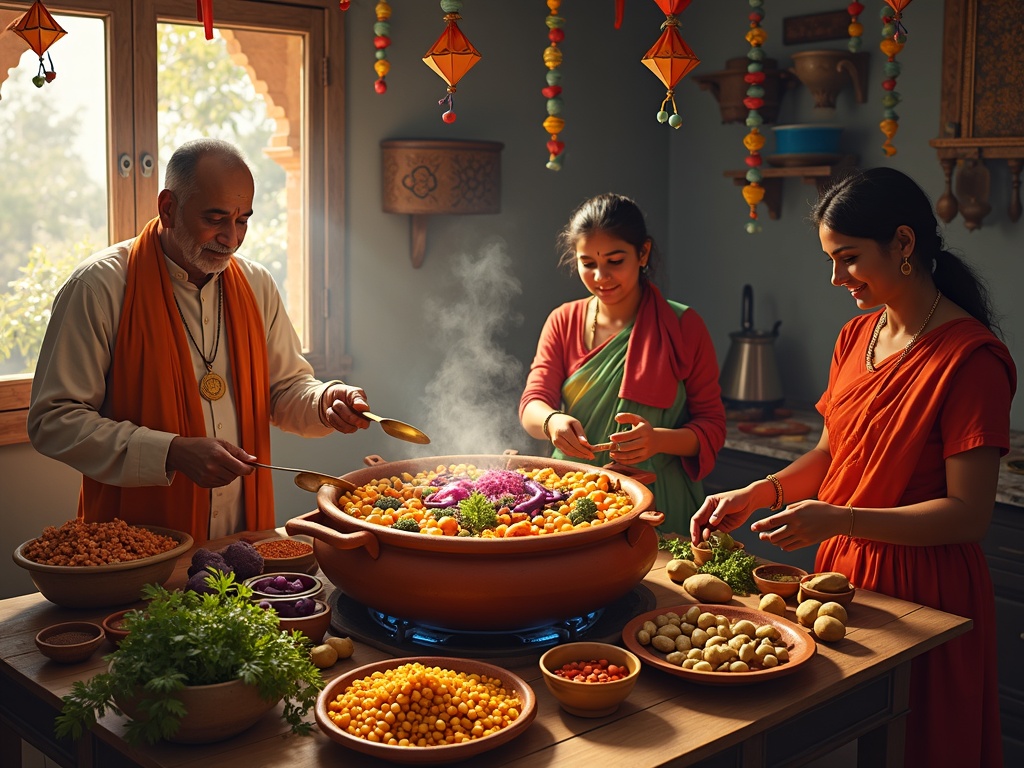Undhiyu, a signature winter delicacy from Gujarat, creates a perfect harmony of seasonal vegetables cooked with fragrant spices and time-honored techniques. This detail-oriented dish carries deep cultural importance, taking center stage during Uttarayan (the kite festival) and celebrating agricultural abundance while building community connections through its shared preparation.
Find In This Article
Key Takeaways
- The dish gets its name from the Gujarati word “undhu” (upside down), referring to its traditional cooking method in underground fire pits that gives it a unique smoky flavor.
- Undhiyu blends winter vegetables like purple yam, eggplants, beans, and potatoes with spiced fenugreek dumplings (muthiyas) in a strategic layering process that keeps individual flavors intact.
- Regional variations exist, with Surti Undhiyu standing out for its spicier profile and traditional preparation methods.
- The dish delivers excellent nutritional value, providing vitamins, fiber, and plant-based proteins while containing only 210-250 calories per serving.
- Typically served with puris or bhakri, undhiyu pairs perfectly with accompaniments like yogurt raita or tamarind chutney that complement its rich flavor profile.
A Winter Delicacy That Defines Gujarati Culture
When winter arrives in Gujarat, families eagerly anticipate the seasonal appearance of Undhiyu on their dining tables. This iconic dish represents more than just food—it embodies the cultural heritage and festive spirit of Gujarati cuisine. I’ve found that understanding the origins and preparation methods of Undhiyu offers fascinating insights into how seasonal cooking shapes cultural identity.
A Symphony of Winter Vegetables
Undhiyu showcases the bounty of Gujarat’s winter harvest through its rich medley of seasonal vegetables. The dish typically includes:
- Purple yam (kand), adding earthiness and natural sweetness
- Small eggplants (ringan), which absorb the aromatic spices
- Fresh green beans (fansi), providing texture and color
- Potatoes (batata), offering heartiness and substance
- Various beans and root vegetables, depending on local availability
Each component plays a crucial role in creating the balanced vegetable curry that has satisfied Gujarati families for generations. The vegetables aren’t randomly combined—they’re carefully selected for their peak freshness during winter months, when their flavors are most robust.
The name “Undhiyu” itself reveals its cooking method—derived from the Gujarati word “undhu,” meaning upside down. This refers to the traditional preparation where clay pots filled with vegetables are placed upside down in underground fire pits. This method imbues the dish with a distinctive smoky flavor that can’t be replicated in regular stovetop cooking.
Cultural Significance and Festive Traditions
Undhiyu holds special prominence during Uttarayan, the winter harvest festival celebrated in mid-January. During this kite-flying festival, families gather on rooftops to enjoy the festivities, with Undhiyu serving as the centerpiece meal. The dish perfectly complements the flavorful vegetable biryani and other festive foods that mark this important cultural celebration.
The preparation of Undhiyu has traditionally been a community activity. I’ve witnessed how neighbors and extended family members come together to prepare the multitude of ingredients—cleaning, chopping, stuffing, and seasoning. This collaborative cooking process strengthens community bonds and passes down culinary traditions across generations.
What makes Undhiyu particularly special is its layering technique. Unlike simple vegetable preparations, Undhiyu follows a specific layering order in the cooking vessel. Each vegetable is placed strategically, with slower-cooking ingredients at the bottom near the heat source. The dish cooks slowly, allowing flavors to meld while maintaining the individual character of each vegetable.
In modern homes, adaptations have emerged to suit contemporary lifestyles. Many families now prepare Undhiyu in pressure cookers or heavy-bottomed pans, yet they maintain the essential layering technique and spice combinations. Despite these adaptations, the dish remains firmly connected to its cultural roots and continues to evoke nostalgia and celebration.
Beyond being just a vegetable-based meal, Undhiyu represents Gujarat’s agricultural heritage and sustainable cooking practices. By featuring seasonal produce at its prime, the dish demonstrates an intuitive understanding of agricultural cycles that predates modern farm-to-table movements.
Whether enjoyed with puffy pooris, steaming rice, or alongside other vegetable dishes, Undhiyu continues to define winter celebrations across Gujarat and in Gujarati communities worldwide. The complex flavors and deep cultural connections make it much more than food—it’s a tangible expression of heritage that brings families together season after season.
The Traditional Art of Making Undhiyu
Undhiyu is a labor of love that celebrates Gujarat’s seasonal bounty. I’ve found that creating this iconic dish involves careful layering and patience, resulting in a melody of flavors that can’t be rushed. The name itself comes from the Gujarati word “undhu,” meaning upside down, referencing its traditional underground cooking method.
Essential Components and Layering Process
The magic of authentic undhiyu begins with selecting the right ingredients. The dish requires:
- Fresh winter vegetables: purple yam, small eggplants, potatoes, beans, and raw banana
- Muthiyas (spiced fenugreek dumplings)
- Spice mix: cumin seeds, coriander powder, turmeric, garam masala, and red chili powder
- Fresh herbs: fenugreek leaves and cilantro for earthiness
- A variety of beans: val papdi (flat beans) and surti papdi add distinctive texture
The layering process is critical to developing depth of flavor. I start by preparing the base with a generous amount of oil infused with cumin seeds. Next comes the heavier vegetables like potatoes and yams, followed by medium-weight vegetables like eggplant and raw banana. The top layer usually consists of delicate items like muthiyas and beans.
Each layer gets its own spice treatment—I carefully season between layers rather than mixing everything at once. This method ensures that every vegetable maintains its distinct flavor while still absorbing the aromatic spices. For added richness, I sometimes include fragrant lentils like toor dal or chana dal between layers.
The traditional cooking method involves an underground oven—a fire pit lined with clay where the pot is placed upside down and covered with coal from above. This creates a unique smoky flavor that’s hard to replicate with modern methods. The slow cooking process typically takes 3-4 hours, allowing all flavors to meld perfectly.
Modern adaptations use pressure cookers or heavy-bottomed pots, but I’ve discovered that a clay pot on low heat creates results closest to the traditional method. The key is patience—rushing undhiyu by increasing heat ruins its signature taste profile.
For home cooks attempting this vegetable masterpiece, I recommend setting aside at least half a day for preparation and cooking. The dish develops a more complex flavor profile when allowed to rest for a few hours after cooking, making it ideal for preparing in advance.
While many regions have their own variations, the coastal Surat style undhiyu with its abundant green garlic and methi muthias remains the most celebrated. Seasonal adjustments are common—summer versions might include more green mangoes while winter versions lean heavily on root vegetables.
What makes undhiyu special isn’t just its complex preparation but how it represents Gujarat’s agricultural heritage through a thoughtful combination of seasonal produce, herbs, and spices. Each bite offers a different flavor profile, telling the story of a region’s culinary history in one magnificent dish.
Health Benefits and Nutrition
Undhiyu isn’t just a feast for the taste buds; it’s a nutritional powerhouse that packs incredible health benefits into each flavorful bite. This traditional Gujarati mixed vegetable dish contains a remarkable balance of nutrients while keeping the calorie count relatively modest at just 210-250 calories per 250-gram serving.
Vitamin-Rich Profile
The diverse vegetable composition makes undhiyu an exceptional source of essential vitamins. The purple yam and leafy greens incorporated into the dish contribute significant amounts of Vitamin A, which supports healthy vision, immune function, and cell growth. I’ve found that a single serving can provide a substantial portion of your daily Vitamin A requirements.
The green beans and fenugreek leaves in traditional vegetable curry preparations like undhiyu deliver impressive Vitamin C content. This crucial antioxidant helps protect your cells from damage, assists with iron absorption, and plays a vital role in collagen production for healthy skin.
Macronutrient Breakdown
Each serving of undhiyu contains approximately 40-50 grams of carbohydrates, making it an excellent energy source. These carbs come primarily from the vegetables rather than refined sources, offering sustained energy release. The dish contains less than 10 grams of fat per serving, most of which comes from the minimal oil used in preparation and the nutritious fenugreek.
The combination of beans, peas, and various vegetables in vegetable dishes like undhiyu creates a fiber-rich meal that supports digestive health. The dietary fiber content helps maintain healthy blood sugar levels, promotes a feeling of fullness, and assists with proper digestion.
Functional Benefits
Beyond its basic nutritional profile, undhiyu offers functional benefits thanks to its unique ingredient composition:
- Fenugreek leaves contain compounds that may help regulate blood sugar levels
- Turmeric used in the spice blend has anti-inflammatory properties
- Green peas provide plant-based protein essential for muscle maintenance
- Eggplant contains anthocyanins that function as antioxidants
- Potatoes offer potassium necessary for proper heart and muscle function
- Beans contribute folate, which is crucial for cell division and DNA synthesis
The seasonal winter vegetables traditionally used in vegetable preparations like undhiyu are harvested at their nutritional peak, maximizing the micronutrient content. The slow cooking method helps preserve these nutrients while enhancing flavor.
I’ve discovered that the combination of vegetables in undhiyu creates a complementary nutrient profile where the absorption of certain vitamins and minerals is enhanced when consumed together. For example, the vitamin C from green beans improves iron absorption from leafy greens.
For those looking to enhance their diet with nutrient-dense foods, incorporating vegetable-based curries like undhiyu can be an excellent strategy. The diverse vegetable content ensures you’re getting a wide spectrum of phytonutrients that aren’t available in simpler dishes.
When prepared with minimal oil, undhiyu becomes an even healthier option that doesn’t sacrifice any of its authentic flavors. Many modern preparations focus on steaming or baking portions of the dish to further reduce the fat content while maintaining the traditional taste profile.

Modern Popularity and Regional Variations
Undhiyu has risen from its humble origins as a traditional winter specialty to become a celebrated dish in Indian restaurants worldwide. This complex medley of seasonal vegetables and aromatic spices has captured the palates of food enthusiasts far beyond Gujarat’s borders. I’ve noticed that authentic undhiyu features prominently on specialty menus during winter months, particularly in areas with significant Gujarati populations.
Regional Variations
Surti Undhiyu stands out among regional variations with its distinctly spicy flavor profile. Originating from Surat in southern Gujarat, this version typically includes a higher proportion of green chilies and spices, creating a more robust taste experience. The preparation also differs slightly, with many Surti homes preferring to cook the dish in clay pots buried upside down in fire pits, lending it a unique smoky character that’s hard to replicate in modern kitchens.
The cultural significance of this dish can’t be overstated – approximately 70% of Gujarati families prepare undhiyu during winter months, making it a cornerstone of seasonal celebrations. Each family often brings their own special touch to the recipe, whether through specific spice blends or the addition of local vegetables unique to their area.
Adaptations of undhiyu vary widely across different regions, with each area incorporating their locally available seasonal vegetables. In some coastal areas, additions like banana flowers feature prominently, while in other regions, purple yams take center stage. Some modern interpretations include:
- Kathiyawadi Undhiyu: Features more garlic and uses fewer leafy greens
- Mumbai-style Undhiyu: Often includes more potatoes and is less oil-heavy
- Ahmedabadi Undhiyu: Typically incorporates more methi muthia (fenugreek dumplings)
- Fusion Undhiyu: Contemporary chefs experiment with non-traditional elements like paneer or mushrooms
Serving Traditions
The full undhiyu experience extends beyond just the dish itself to its complementary accompaniments. Traditionally served with freshly fried puris or rustic bhakri, these breads provide the perfect vehicle for scooping up the flavorful vegetable medley. The contrast between the crisp bread and the tender, spiced vegetables creates a delightful textural interplay.
To balance the rich, spicy profile of undhiyu, it’s commonly accompanied by cooling side dishes. A dollop of plain yogurt or a tangy vegetable chutney helps temper the heat while adding another dimension of flavor. Many families have their own signature accompaniments that have been perfected over generations.
The final touch to any properly served undhiyu is its garnish. A generous sprinkling of fresh cilantro adds brightness, while a squeeze of lime juice cuts through the richness with welcome acidity. These simple additions highlight the vegetable flavors and bring the entire dish into perfect balance.
I’ve found that modern presentations sometimes incorporate innovative plating techniques, but the most satisfying undhiyu experiences remain true to the communal serving style – a large, steaming pot placed at the center of the table for everyone to share, embodying the Gujarati tradition of generous hospitality.
Community and Cultural Impact
The preparation of undhiyu represents far more than just cooking a meal—it embodies the spirit of Gujarati tradition and family unity. I’ve observed how this iconic dish brings multiple generations together in the kitchen, each person assigned a specific role in the intricate preparation process. Grandmothers often oversee the spice blending, while younger family members might be tasked with peeling the small eggplants or preparing the muthiyas (steamed dumplings).
Sustainable Cooking and Community Bonds
Undhiyu exemplifies sustainable cooking practices through its deliberate use of seasonal winter vegetables. The dish showcases the best local produce available during the winter months, including:
- Surti papdi (flat beans), which are at their peak during winter
- Tender purple yams, harvested during the cooler months
- Fresh green garlic, a seasonal winter ingredient
- Unripe bananas, providing texture and substance to the dish
This seasonality isn’t just about flavor—it connects communities to local agricultural rhythms and supports regional vegetable farming practices. The process of sourcing these ingredients often involves visits to local markets, strengthening the relationship between consumers and farmers.
The communal nature of undhiyu preparation has made it central to winter celebrations in Gujarat. During Uttarayan (the kite festival) and other winter festivities, neighbors often exchange portions of their homemade undhiyu, creating an informal food network that strengthens community bonds. I’ve seen entire neighborhoods filled with the distinctive aroma of this complex vegetable dish during these celebrations.
What makes undhiyu particularly special is how it transforms ordinary vegetables into something extraordinary through shared effort. The labor-intensive preparation becomes less burdensome when divided among family members, turning potential drudgery into a bonding experience. This collaborative cooking approach has helped preserve traditional culinary techniques that might otherwise fade in our fast-paced world.
In modern times, undhiyu continues to evolve while maintaining its cultural significance. Community cooking classes featuring this dish have become popular, allowing the tradition to spread beyond Gujarati households while maintaining its status as a symbol of heritage and communal harmony.

Serving and Pairing Traditions
I’ve found that undhiyu’s complex flavors deserve thoughtful accompaniments that enhance rather than overshadow its distinctive taste. This Gujarati mixed vegetable delicacy reaches its full potential when paired with the right bread and condiments.
Classic and Contemporary Accompaniments
The most traditional way to enjoy undhiyu is alongside hot, puffy puris fresh from the stove. These deep-fried Indian breads create a perfect textural contrast to the hearty vegetables. The slight crispness of the puri’s exterior gives way to a soft interior that’s ideal for scooping up the flavorful undhiyu mix. For a healthier alternative, I often serve undhiyu with millet flatbread (bhakri), which adds a rustic, nutty flavor while making the meal more nutritious and easier to digest.
To balance the richness of undhiyu, these side dishes work beautifully:
- Tangy yogurt raita that cools the palate between bites of spiced vegetables
- Sweet-sour tamarind chutney that cuts through the richness
- Fresh green chutney made with cilantro, mint, and green chilies
- Simple kachumber salad with diced cucumber, tomatoes, and onions
The finishing touch to a well-plated undhiyu is a generous sprinkle of fresh cilantro leaves and a squeeze of lime juice right before serving. These bright elements lift the entire dish and highlight the freshness of the ingredients.
What makes undhiyu particularly special is its balanced flavor profile. Despite containing numerous vegetables and spices, each component retains its distinct character while contributing to the harmonious whole. The earthy tubers, creamy beans, and crisp seasonal vegetables create a medley that’s greater than the sum of its parts.
In Gujarati homes, undhiyu holds a cherished place at festive gatherings, particularly during Uttarayan (the kite flying festival) in January when winter vegetables are at their peak. It’s also commonly prepared for wedding feasts and important family celebrations. The communal nature of preparing this labor-intensive dish makes it all the more special – multiple family members often pitch in to clean, chop, and stuff the vegetables.
For a complete Gujarati feast, I like to serve undhiyu with sweet and sour dal, fragrant steamed rice, and a simple kadhi (spiced yogurt soup). This creates a meal with contrasting flavors and textures that’s both satisfying and memorable.
Modern interpretations sometimes pair undhiyu with fusion elements like garlic naan or even as a filling for wraps and sandwiches. Some innovative chefs have begun serving deconstructed undhiyu as part of tasting menus, highlighting each vegetable’s unique preparation.
No matter how it’s served, undhiyu remains a celebration of seasonal abundance and vegetable cooking techniques that have stood the test of time. Its ability to transform humble ingredients into something extraordinary makes it a standout dish in India’s vast culinary landscape.
Sources:
Indian Food History Journal: The History of Undhiyu: A Traditional Gujarati Recipe
Journal of Nutrition and Food Sciences: Nutritional Values of Traditional Indian Dishes
Gujarat Cultural Review: Cultural Significance and Festivities in Gujarat
Journal of Culinary Evolution: Seasonal Ingredients and Their Impact on Gujarati Cuisine

